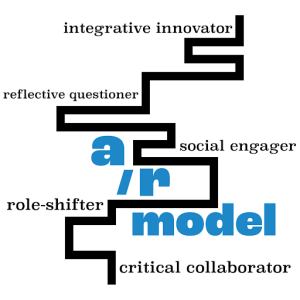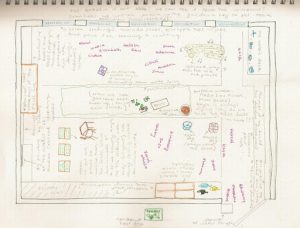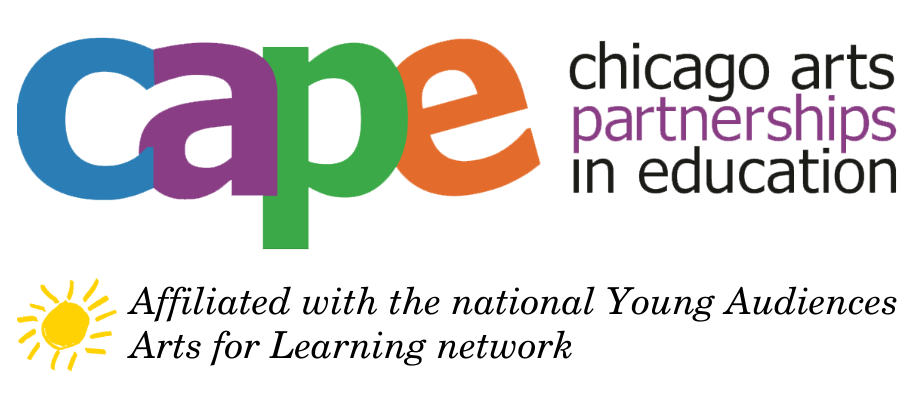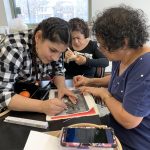SCALE After School Program Research 2022-2023
Research and Interactive Activity Included in PERSPECTIVE(s) Exhibition April 11 – May 3

![]()
Research partners at Creativity Labs/University of California Irvine exhibit recent findings and an activity in CAPE’s 2022-2023 PERSPECTIVE(S) After School Exhibition, April 11-May 3, 2023.
A Research Partnership Exploring: Openness, Space & Place, and Positionality in Arts Learning Environments
Under the direction of Dr. Kylie Peppler, Creativity Labs at the University of California, Irvine designs and studies in- and out-of-school learning experiences rooted in constructionist principles, particularly those around creativity, making, and learning.
All CAPE Partners are Artist/Researchers: In collaboration with researchers from Creativity Labs at UCI, CAPE Artist/Researchers ask critical questions, engage students and community members, and create new ways of teaching and engaging in the arts.
Artist/Researcher Model

Partnership Timeline
2019-2020
CAPE and UCI Team worked toward shared line of inquiry on openness, began to write and get approval through UCI Institutional Review Board and Chicago Public Schools Research Review Board (RRB)
2020-2021
CAPE and UCI Team began interviews with teaching artists, explored concept of openness in relation to their classroom practice (in wake of the pandemic)
2021-2022
CAPE and UCI Team further explored openness with teachers and teaching artists and began discussing explorations of physical and relational space and place making
2022-2023
CAPE and UCI Team seek to build upon the work over the last few years and incorporate reflections on positionality in relation to teachers’ and teaching artists’ classroom practice
Research Highlight: Space & Place
Last year (2021-22), CAPE Teaching Artists considered Space and Place in their teaching environments, using drawings and video descriptions (dérives) to explore the following research questions:
- How do artist-teacher pairs choose to represent the spaces where they teach?
- In what ways do these representations mark the physical and relational dimensions of space/place?
Example: Kayla’s drawing of the gardening club classroom space
Conclusions:
- We found that artist-teacher dérives represented space by emphasizing and describing physical and relational dimensions of space.
- The significance of this work is in how the practice of representing the co-construction of space and place can support the design of learning environments that consider the ways in which spaces/places restrict and afford learner agency.
Dahn, M., Adesida, T., Sikkema, S., & Peppler, K. (2023, April 13-16). Physical and Relational Space Making through Representational Videos of Arts Afterschool Programs [Conference Roundtable Session]. AERA, Chicago, Il, United States.
Research Highlight: Positionality
This year (2022-23), CAPE Teaching Artists are expanding on their study of Space and Place by considering concepts of positionality.
Through activities in professional development, reflective questions and interviews, they are currently considering the following research questions:
How do CAPE teaching artists reflect on their own positionality and power in the classroom?
What are the range of ways that positionality is engaged in teaching artists’ work and teaching?

[Image: Interactive Positionality Map – PERSPECTIVE(s) Exhibition April 11 – May 2, 2023]
Initial Discoveries from CAPE Teaching Artists: Understanding Positionality
Note: Research in progress
- A better understanding of our own positionality can help us gain perspective and treat others the way we’d like to be treated.
- My positionality provides the initial perspective of the world. I need to take the time to intentionally pivot to another perspective to better address my students’ needs. Even better, is when I can hand over the viewing lens from me to them.
- Cultural relevance leads to engagement, valuable experiences, and deep learning.
- Because of my view and understanding of my positionality, histories, systems, and structures I try to remain open and not put my assumptions on my classes. We typically begin with an open approach to seeing what is on people’s minds and even what materials they are interested in exploring.
Sharing Our Findings:
Publications and Presentations
2021
How the arts can unlock a closed curriculum. Kappan. 102, 20-25.
“Way More Relevant and a Little Less Theoretical’: How Teaching Artists Designed for Online Learning in a Pandemic.” Learning, Media, and Technology.
Learning to be open: Expansive family networks, emotional support, and shared practices as connection pathways. International Society of the Learning Sciences (ISLS)
The Connected Arts Learning Framework: Insights from CAPE. Connected Learning Summit (CLS)
2022
“Keeping them with us”: Constructing equitable online spaces for the theatre classroom. International Society of the Learning Sciences (ISLS)
Performing arts in the digital space: Handling uncertainty by reshaping expectations and seizing opportunities. American Educational Research Association (AERA)
2023
“Let’s Go; We’re Writing a Song”: Co-Creating Auditory and Placial Space in an Afterschool Music Program. International Society of the Learning Sciences (ISLS)
Physical and Relational Space Making through Representational Videos of Arts Afterschool Programs. American Educational Research Association (AERA)
Cawelti, L., Dahn, M., Peppler, K., Adesida, T., Cuéllar, N., Livas, M., Meryhew, N., & Sikkema, S. (2023). “Let’s Go; We’re Writing a Song”: Co-Creating Auditory and Placial Space in an Afterschool Music Program. In: NAMES (Eds.) International Collaboration toward Educational Innovation for All: International Society of the Learning Sciences (ISLS) Annual Meeting 2023. Montreal, Canada: International Society of the Learning Sciences.
Dahn, M., Adesida, T., Sikkema, S., & Peppler, K. (2023, April 13-16). Physical and Relational Space Making through Representational Videos of Arts Afterschool Programs [Conference Roundtable Session]. AERA, Chicago, Il, United States.
Yankova, N., Dahn, M., Peppler, K., Lee, J., Montgomery, A., Moser, S., & Sikkema, S. (2022, June). “Keeping them with us”: Constructing equitable online spaces for the theatre classroom. In C. Chinn, E. Tan, C. Chan, & Y. Kali, (Eds.) International Collaboration toward Educational Innovation for All: ICLS Proceedings: 16th Annual Conference of the Learning Sciences (ICLS) 2022 (pp. 2138-2139). Hiroshima, Japan: International Society of the Learning Sciences.
Yankova, N., Dahn, M., Peppler, K., Lee, J., Montgomery, A., Sikkema, S., Spilberg, J., & Adesida, T. (2022, April). Performing arts in the digital space: Handling uncertainty by reshaping expectations and seizing opportunities. Presented at the American Educational Research Association Annual Meeting, San Diego, CA.
Sikkema, S., Lee, J., Spilberg, J., Dahn, M., Yankova, N., Peppler, K. (2021). How the arts can unlock a closed curriculum. Kappan. 102, 20-25.
Dahn, M., Yankova, N., Peppler, K., Sikkema, S., Spilberg, J., & Lee, J. (2021). “Way More Relevant and a Little Less Theoretical’: How Teaching Artists Designed for Online Learning in a Pandemic.” Learning, Media, and Technology.
Dahn, M., Yankova, N., Peppler, K., Lee., J., Montgomery, A., Sikkema, S., & Spilberg, J. (2021, June). Learning to be open: Expansive family networks, emotional support, and shared practices as connection pathways. Proceedings of the International Society of the Learning Sciences Annual Meeting. Bochum, Germany.
Peppler, K., Dahn, M., Sedas, M., Yankova, N., Sikkema, S., Spilberg, J., Lee, J., & Montgomery, A. (2021, July). The Connected Arts Learning Framework: Insights from CAPE. Presented at the Connected Learning Summit (CLS), July 1-31, 2021






